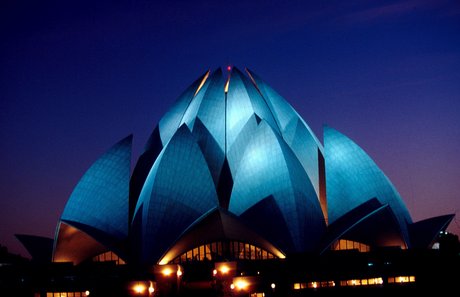Circles of adoration
On the day of the first Naw-Rúz He celebrated after His release from captivity - 21 March 1909 - 'Abdu'l-Bahá had a marble sarcophagus transported to the vault He had prepared for it. In the evening, "by the light of a single lamp, He laid within it, with His own hands—in the presence of believers from the East and from the West and in circumstances at once solemn and moving—the wooden casket containing the sacred remains of the Báb and His companion," wrote Shoghi Effendi.
"When all was finished, and the earthly remains of the Martyr-Prophet of Shíráz were, at long last, safely deposited for their everlasting rest in the bosom of God's holy mountain, 'Abdu'l-Bahá, Who had cast aside His turban, removed His shoes and thrown off His cloak, bent low over the still open sarcophagus, His silver hair waving about His head and His face transfigured and luminous, rested His forehead on the border of the wooden casket, and, sobbing aloud, wept with such a weeping that all those who were present wept with Him. That night He could not sleep, so overwhelmed was He with emotion."
Last Saturday, I was privileged to join some 1000 Bahá'ís – pilgrims, visitors, guests and staff of the Bahá'í World Centre - gathered on that same mountainside and, in an act of solemn reflection, circumambulate the Shrine of the Báb, 100 years to the day since 'Abdu'l-Bahá had completed that singular act which, wrote Shoghi Effendi, "indeed deserves to rank as one of the outstanding events in the first Bahá'í century."
How transformed is this rocky mountainside since the night when 'Abdu'l-Bahá brought the Báb's remains to their final resting place, close to that circle of cypresses, in a mausoleum befitting a Messenger from God Who had declared His mission on the very night of the very same year that 'Abdu'l-Bahá Himself was born.
Last year alone, the Terraces of the Shrine of the Báb attracted some 640,000 visitors and their beauty is being universally acclaimed. Last Monday, in Jerusalem, a special reception was held to celebrate the addition of the Bahá'í shrines and gardens to the UNESCO World Heritage list. Commenting on the achievement, Israel's Interior Minister Meir Sheetrit, said that the shrines reflect peace, beauty and tolerance. He said it was not only an honour for Israel to have the Bahá'í Holy Places within its borders, but it was an honour for UNESCO to have them on its list of the world's most culturally significant places.
"The sacrifices of the Báb and the dawn-breakers of the Cause are yielding abundant fruit," wrote the Universal House of Justice at Naw-Ruz, the exact centenary of the interment of the Báb's remains on Mount Carmel, "The magnificent progress achieved over the past century demonstrates the invincible power with which the Cause is endowed."
As we processed from the Seat of the Universal House of Justice, along the semi-circular arc path to the Shrine of the Báb, I turned back and glimpsed the multi-coloured parade of humanity in all its diversity, moving together as one soul in many bodies. I remembered the dramatic circumstances surrounding the Báb's own execution and the vain hope of the clergy and rulers of His land that, with His swift demise and the brutal massacre of some 20,000 followers, the fire He had ignited would be quenched. The vision of humanity I glimpsed on Saturday demonstrated to me the futility of such attempts to snuff out this inextinguishable light - efforts which persist in Iran to this day. "He doeth as He doeth and what recourse have we? He carrieth out His will, He ordaineth what He pleaseth."
'Abdu'l-Bahá's depositing of the remains of the Báb in the bosom of Mount Carmel marked the beginning of the World Centre of the Bahá'í Faith. It was an act of love and obedience carried out by a son on the instructions of His Father. A seed, still bursting with life and potential, had been salvaged from a savagely felled tree and planted in new soil where it could take root. The circle of cypress trees, silent witnesses to momentous events, are now overshadowed by the efflorescence of Carmel, both in the magnificence of the gardens that now adorn its slopes and the vibrant variety of human hues that gather there in their thousands to pay homage to the martyred herald of their Faith. Today, these are the fruits of that seed, of that act of obedience.
As the Universal House of Justice noted, "It is but a portent of the ultimate realization of the oneness of humankind."
Read the whole post here.

